Barbara Schmidt, 25 Reasons Why to Wear Jewellery. Munich, Germany: Druckerei Vogl GmbH&Co, 2016.
How often do we have the opportunity to explore contemporary art jewelry[1] through short stories written by one of our own? I enjoy reading, but I find academic writing tedious, so Barbara Schmidt’s book 25 Reasons Why to Wear Jewellery grabbed my attention.

This collection of short, fictional stories illustrates the 25 (or thereabout) reasons people wear jewelry. The list of reasons that provide the structure of the book originated from the discovery of 75,000 decorative elements in Blombos Cave, South Africa, by archaeologists in the 1990s.[2] Marian Vanhaeren, who studied these ancient objects, identified 14 reasons the items were worn, including jewelry as amulet and talisman, as barter object, as social marker, and as object for counting. The author adds 13 more reasons for good measure: jewelry as humor and as a tool, giving us 27 stories illustrating why people wear jewelry.
In the preface, the author explains how the anthropologist’s reasons are relevant today but, interestingly, she doesn’t include images of the ancient objects. Instead, Schmidt shares images of contemporary art jewelry. Some might miss seeing the archaeological objects, but their displacement by contemporary objects is refreshing, especially given the decidedly unhistoric and experimental tenor of this book.

Some of the contemporary art jewelry simply graces the table of contents or acknowledgment pages, like the piece shown above. Another 27 pieces appear in creative ways throughout the book, driving its design and framing the development of the short stories.

As shown above in the design of the spreads for the section Jewellery as a Gift of Love, the bright green color from the necklace by Dorothea Förster appears again on the next page as the overleaf to the story Green Shivering. This design concept repeats throughout the book: one of the 25 reasons serves as a title for each section, a stunning, full-page image opens the text, and a color from the jewelry echoes at each ending. The variety of colors in the jewelry results in a joyful explosion of saturated pages of color that make reading the book enjoyable and clearly demarcate each story. Each one ends with its image’s caption, enticing the reader to flip back and reexamine the jewelry with new identifying information. The artist’s website is also included in the caption, allowing for further exploration—a nice touch.
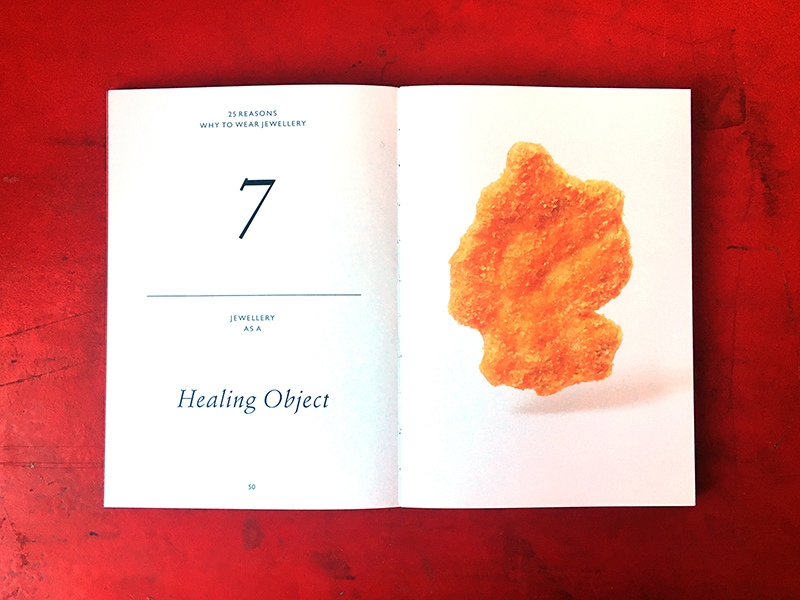
The second way contemporary art jewelry features in this book is as inspiration for the content of the short stories. In the seventh one, Amber for Beginners, Gisbert Stach’s brooch DE-Schnitzel (2015), a well-known example of nontraditional use of amber, acts as the visual anchor for Jewellery as a Healing Object. The story itself isn’t about the piece directly—what a story about an amber schnitzel brooch would be about, I couldn’t say. Instead, the story is about a person’s interaction with a small amber elephant he carries in his pocket, the palliative effect of the stone, and the resulting improvement to his love life.
I’ll pause here to say that an unabashed body awareness manifests heavily in this book, in both subtle and heavy-breathing kinds of ways. Jewelry is nothing without the living body that carries it, so it makes sense. I found it a welcome (and sometimes humorous) shift from the academic terms I often see attempting to associate jewelry with bodies and bodily acts. In this book, bodies shiver, hips circle, and throats are naked but for their pearls.
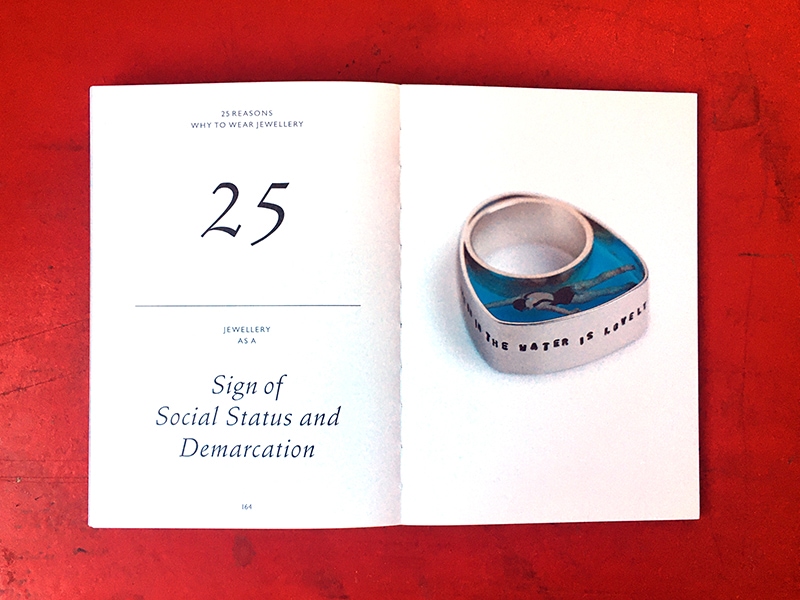
While some of the stories take inspiration from the material or the color of the associated jewelry, others make a connection with the subject matter of the jewelry object itself. That’s the case for the 25th story, Princess of the Sea, which pulls from the water-focused theme of Helen Noakes’s ring, Come In, The Water Is Lovely (2016). The story follows a schoolgirl who receives a special ring that marks her as an elevated water-being, appropriate for the section focused on Jewelry as a Sign of Social Status and Demarcation. Full of references to water, with Poseidon and mermaids making appearances, along with ideas of classism and royalty—but wait, don’t forget about climate change, we’re talking about the ocean here!—the story takes on a lot. The connections between the jewelry object, the reason to wear jewelry, and the storyline aren’t subtle. It often seems the story’s flow chart is right at the surface.
This neat combining of all the elements within these stories is the least successful part of this otherwise delightful book. The stories are heavy with metaphors and descriptive phrases that work hard to bring all the elements into a cohesive story. It’s a lot to ask of any short story to carry so much and remain engaging. As an avid reader of short stories, I recognize the incredible skill it takes to use few words to develop a full story experience. Some say it’s the most difficult fiction genre to master.
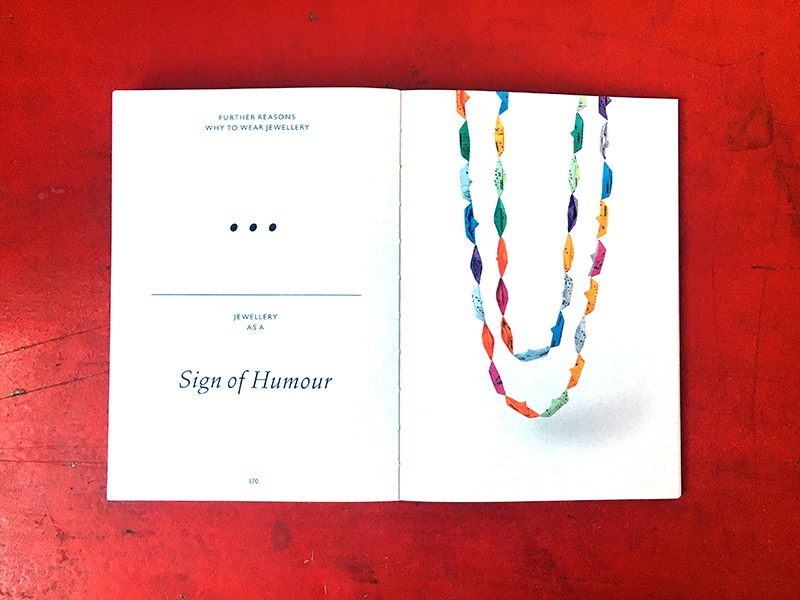
In one of the last stories, Small World, in the section Jewellery as a Sign of Humour, there’s a definite shift in the flow of the language in the story. This story, written by the author’s son, is the only one in the collection written by someone else. The rhythm of its language is a marked contrast to the others, even as it follows the parameters of the book.
There’s an additional change in format with three stories dedicated to the maker of the jewelry object featured in the piece: Friedrich Becker, Carl Dau, and Giovanni Corvaja. These stories meditate on the objects intimately, focusing on process, color usage, and material in turn. Lastly, the hardworking Indian jewelry assembly-line worker also has a story dedicated to his labor and skill.
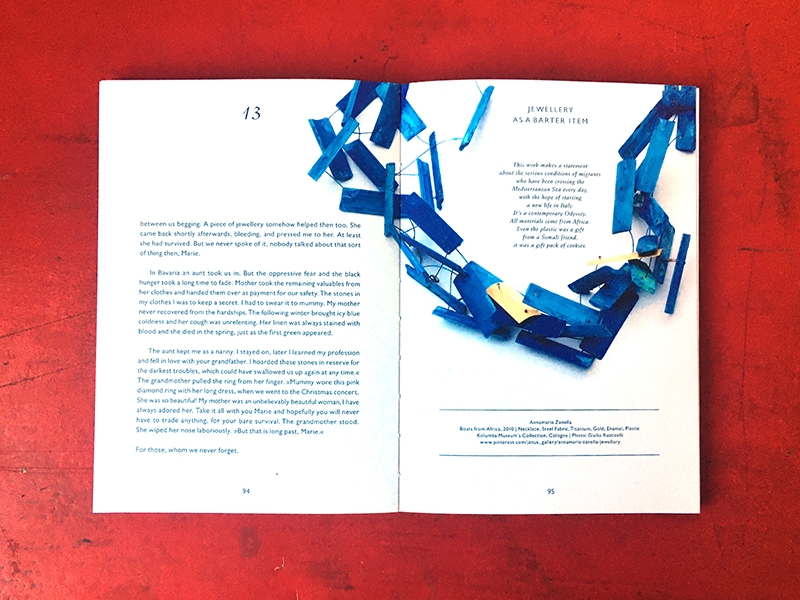
The idea to create a book of short stories using contemporary art jewelry as the framework is noteworthy and results in a visual feast, regardless of the literary quality of the stories. 25 Reasons Why to Wear Jewellery is a playful look at the variety of reasons people have worn and continue to wear jewelry, written by someone knowledgeable about the field. For the beautiful layout, the thoughtful selection of current pieces of art jewelry, and the insightful idea to use fiction to deepen the jewelry conversation, I’m grateful to Barbara Schmidt for stepping outside the academic essay format and creating this unique book for our enjoyment.
Storytelling has the ability to capture the inexplicable, sentimental, and deeply human aspects of our longing for adornment. We in art jewelry strive for a larger audience and often seek external legitimacy through academia. Perhaps another way of broadening the appeal of contemporary art jewelry is to allow the magic and creativity of jewelry to free the imagination and give voice to the story each piece contains.
US-based readers interested in purchasing this book may contact Charon Kransen Arts for pricing and shipping via charon [at] charonkransenarts [dot] com. All other readers, contact Barbara Schmidt directly at bs [at] barbara-schmidt-schmuck [dot] de.
+++
你需要多少原因来选择佩戴的首饰
25 Reasons Why To Wear Jewellery回顾文
By Rebekah Frank
Ucic艺术首饰翻译
Barbara Schmidt,《佩戴首饰的25条理由》。慕尼黑,德国:Druckerei Vogl GmbH&Co,2016
我们一生中有多少机会通过我们自己写的小故事来探讨当代艺术首饰?我喜欢阅读,但我觉得学术性的文章有些乏味。当Barbara Schmidt撰写的《佩戴首饰的25条理由》一书出版时,立刻引起了我的注意。
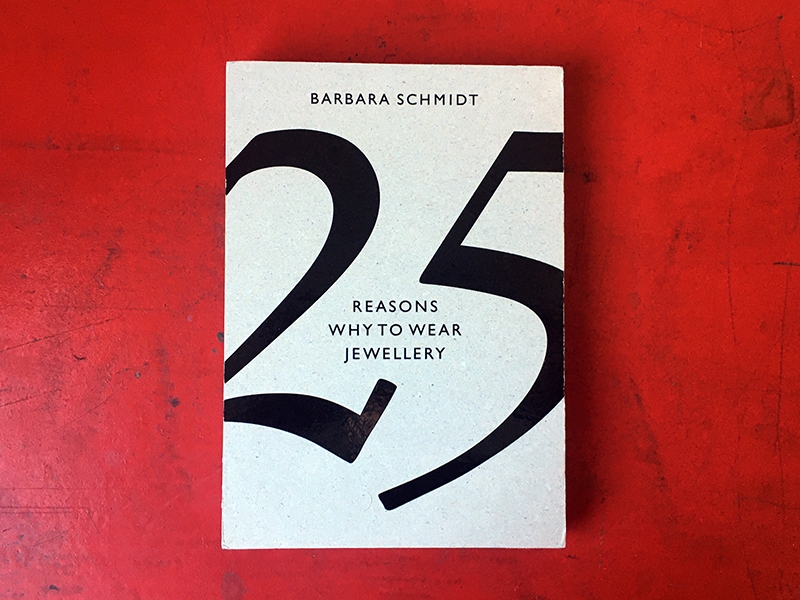
这本小说式的短篇故事集阐述了人们佩戴首饰的25个理由。这本里程碑式的当代首饰书的灵感来源 是20世纪90年代考古学家在南非Blombos Cave(布隆博斯洞穴)发现的7.5万个装饰元素。在研究了这些古代饰品之后,Marian Vanhaeren整理归类出了14个人们需要佩戴首饰的理由,其中包括让首饰作为护身符,易货物品,社交标记,以及作为计数对象的功能性物件。在此之后,作者又在自己的研究基础上补充了更为细腻的13个理由,其中就包括:首饰也是一种幽默的语言和社交的工具。Schmidt通过27个故事给我们讲述了人们为什么要佩戴首饰。
在序言中,Marian Vanhaeren从人类学的角度出发解释了这些佩戴首饰的理由是如何与今天的我们穿戴首饰的情况息息相关的。有趣的是,她没有在行文当中花大量的篇幅去描述古代物品。相反,作者Schmidt在书中贯穿分享了相关的当代艺术首饰的作品图片。或许有些人会在这里更想见到作者用更多的笔墨去描述古代的物件,但取代它们的当代艺术首饰肯定不会让读者失。考虑到这本书中明显的非历史性和实验性的要旨,这样的内容安排再恰当不过了。

如上图所示,有些当代艺术首饰只是在目录或致谢页上作为排版点缀出现。而另有27件作品巧妙地被布局在全书各处,串联起了整本书的逻辑设计和短篇小说式的构架发展。

在这本书中,”首饰是爱的馈赠”一节的版面设计非常特别。Dorothea Förster那鲜明的绿色的项链在前后页中相互呼应,作为故事”绿色颤抖”的扉页尤其让人过目难。这种重复的设计理念在全书中都有体现:25个理由中的上一个作品会作为下一部分的标题,用一张惊艳的整版图片开启后续的文字之旅。首饰中的一种颜色则会在每一份文案的结尾处相互呼应成趣。首饰中的各种颜色让一页页色彩饱和度欢乐迸发,让阅读本书的过程充满意外与惊喜,也清晰地划分了每章篇幅。每一个故事的结尾都有其图像相配的说明文字,吸引读者回味阅读,并以此作为新的识别信息让读者重新审视这些首饰。书中图像的说明处还包含了艺术家的个人网站链接,让读者可以更进一步的探索——不得不说这是一个很用心的细节。

当代艺术首饰在本书中的第二种呈现方式是作为短篇小说的灵感源泉。在第七篇“初学者的琥珀“中,Gisbert Stach的胸针DE-Schnitzel(2015)就是关于琥珀的一个非常规使用的著名例子——在这件作品中,琥珀是“作为治愈对象的首饰“的视觉定位点。书中的故事本身并不是直接关于这件作品——作品是琥珀炸肉排胸针(作品标题是Schnitzel,意为炸猪排)的故事,相反,这里的故事讲述的是一个人与他口袋里携带的小琥珀的互动,讲述了这枚小石头带来的灵魂舒缓作用,以及它伴随而来的那美好的爱情生活。
我想表达的是,在这本书中读者能够体会到大量的不折不扣的人类原始的意识。这些情感或细微,或凝重。如果没有承载它的活生生的人类身体,首饰就什么都不是,这也就是它们本身的非凡意义。我发现,那些试图将首饰与身体及身体行为联系起来的学术术语发生了转变——这是受读者欢迎的(有时是幽默的)转变。在这本书中,所有颤抖的身体,旋转的臀部,裸露的喉咙……这些肢体语言,都是为了向他们佩戴的珍珠讲述自己私密的情事。

在这本书中,有些故事的灵感则是来自于相关首饰的材质或颜色,而另一些故事则与首饰物件本身的主题密不可分。第25个故事“海的公主”就是如此:它取材于Helen Noakes的戒指’进来吧,水很可爱’(2016)中以水为主题的作品。故事讲述了一个平凡女学生在一天收到一枚特殊的戒指,这枚戒指意外让她成为了一个高高在上的水神,踏破了现实的边界。这枚戒指成为了“划分社会不同地位和阶级的标志”。整篇文章都充满了对水的引用,Poseidon(波塞顿,希腊神话中的海神)和美人鱼反复出现,以及阶级主义和对古老皇室的想法等等。当然还有气候变化问题,故事离不开海洋!这个故事包含了很多纤细微妙的情感细节。在现实生活中,首饰物件、佩戴首饰的原因和故事情节之间的联系并不微妙。但在本书中,很多时候故事的流程看上去流于表面,但实际上是能让人更轻松地去熟悉故事的发展与内涵。
这些故事内所有元素的巧妙结合是这本书的成功点之一。这些故事原本都背负了沉重的隐喻和描述性的短语,作者努力将所有的元素串整合在一起,创造了一个个连贯的故事。对任何一个短篇小说来说,要承载这么多信息并且依旧能引人入胜是非常困难的。作为一个热衷于阅读短篇小说的读者,我清楚地知道到用很少的文字来完成一个故事需要非常高超的叙事技巧。经常有人说这是最难掌握的小说类型。

在最后一个故事“小世界”中,在其中一节 “首饰也是幽默的标志 ”里,书中故事的语言表达习惯有了明显的变化。这个故事是作者的儿子写的,也是全集中唯一一个由别人完成的故事。即使能够读出小作者想极力地与他母亲的书写风格保持一致,但故事的语言节奏还是和其他故事大相径庭。
在这本书中,有三个故事专门介绍了作品中首饰物件的制作者,在形式上略微区别于其他篇幅。这三位制作者分别是Friedrich Becker、Carl Dau和Giovanni Corvaja。故事对他们的物品进行了详尽的描述,依次解构了它们的工艺、色彩运用和材料。在书的最后,也有一个故事致敬了勤劳的印度首饰制作流水线工人,专门讲述他的劳动和技术的故事。
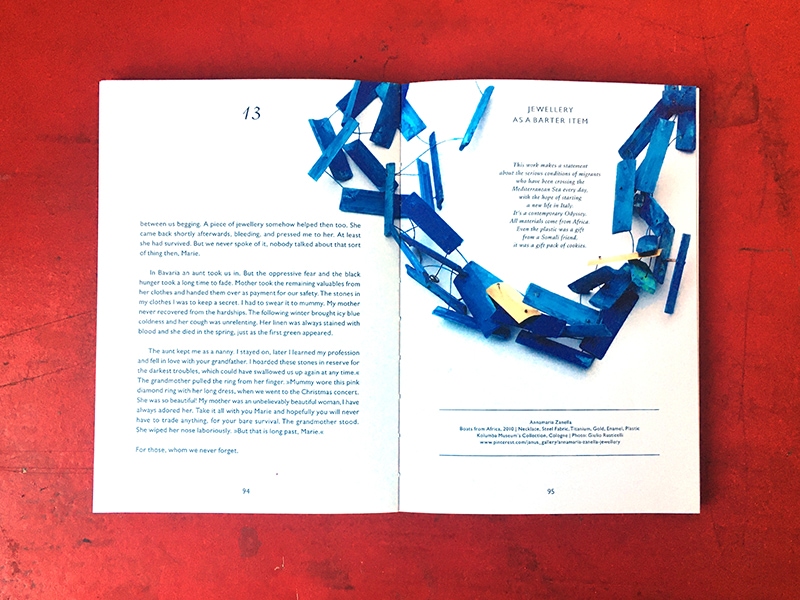
以当代艺术首饰为框架创作一本短篇小说集的想法值得赞扬,无论故事的文学性如何,这种创新角度下诞生的书籍都能带来一场视觉盛宴。《佩戴首饰的25个理由》是由艺术首饰领域的有识之士所撰写的。它以耐人寻味的方式讲述了人们佩戴和继续佩戴首饰的各种理由。它精美的版式包装下潜藏的是作者对当下艺术首饰的深思熟虑用心选择,以及用小说来深化首饰话题的精辟构思。我很感谢Barbara Schmidt能够跳出传统学术论文的形式,创作出这本独特的书供大家欣赏。
这本书里的故事仿佛有魔力一般,精准地捕捉到了我们对装饰品的渴望中莫名其妙的、感性的、深具人性的一面。我们从事艺术首饰的匠人一直想要的就是努力争取更多的观众,并经常通过学术界寻求艺术创作之外的精神性延展的可行性。或许,扩大当代艺术首饰吸引力的另一种方式就是像这本书一样让首饰的魔力和创造力释放出想象,让每件作品所包含的故事发出他们特有的声音。
[1] 25 Reasons Why to Wear Jewellery was translated from German using the British spelling “jewellery,” but AJF style uses the American “jewelry” when referring to ornament, while keeping original spellings in titles—hence the multiple spellings in this essay.
[2] For more information about the Blombos Cave, start here for the basics, then search further from there: https://en.wikipedia.org/wiki/Blombos_Cave.





